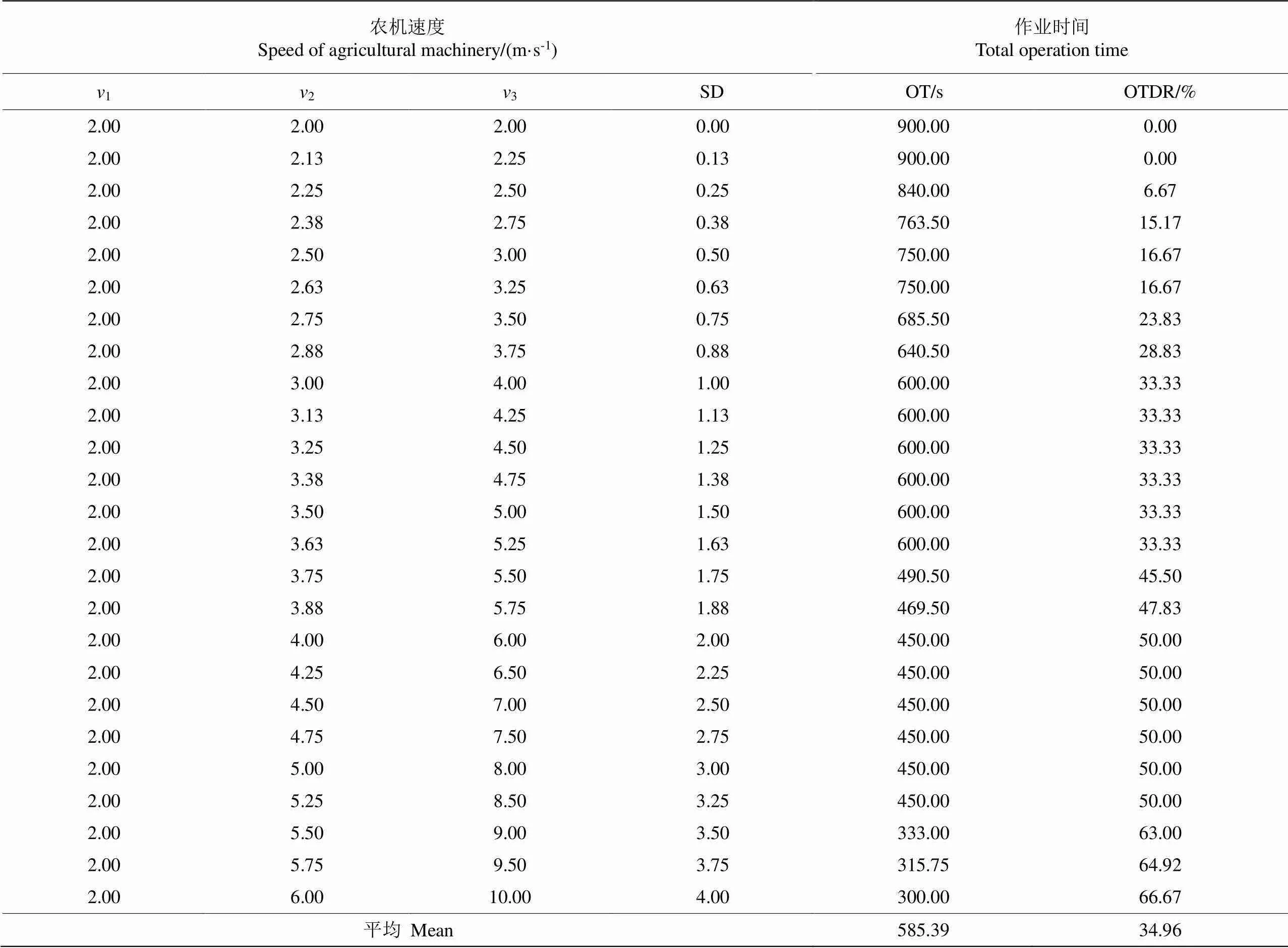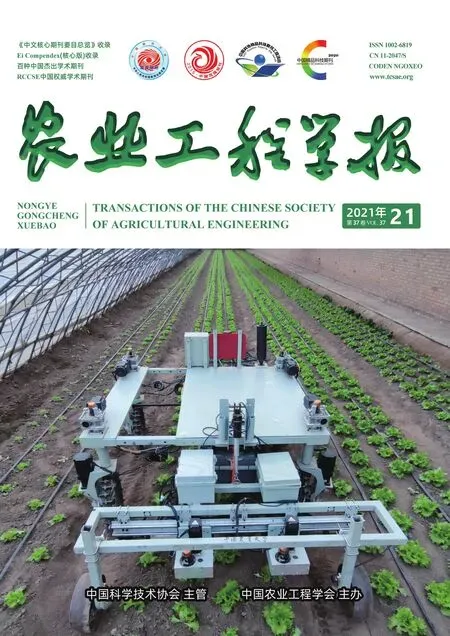不确定场景下无人农机多机动态路径规划方法
梁亚杰,杨丽丽,徐媛媛,陈智博,冯雅蓉,吴才聪,2
·智慧农业技术与装备·
不确定场景下无人农机多机动态路径规划方法
梁亚杰1,杨丽丽1,徐媛媛1,陈智博1,冯雅蓉1,吴才聪1,2※
(1. 中国农业大学信息与电气工程学院,北京 100083; 2. 农业农村部农业信息获取技术重点实验室,北京 100083)
在现代化农业中,越来越多的龙头企业或农村合作社提供一系列的农业作业专业化服务,引入多台农机进行规模化作业,不仅提高了效率,而且可以实现抢种抢收,减少自然灾害的风险。目前,多台农机并行作业仍以预先计划的固定农机和静态的固定路线为主,但在实际耕种、收割等作业中,常会出现农机突发故障、农机临时增加、农机工作效率不一致等不确定场景,这些不确定性给多台农机集群控制带来巨大挑战。因此,研究不确定场景下多机动态路径规划方法具有十分重要的理论意义和实用价值。该研究以总作业时长为综合优化目标,综合各种不确定场景,针对轮式自动驾驶拖拉机,提出了改进的迭代贪婪(Improved Iterated Greedy, IIG)方法进行多机动态路径规划,解决以往传统方法在不确定情况发生后路径规划结果低效甚至失效的问题。试验表明,该方法在不确定场景下可及时、高效的动态调整路径规划方案,能够为不同数量、不同性能的农机迭代找到当前最优路径。与传统的并排作业方法相比,IIG优化的矩形农田作业路径总作业时间平均下降约35%,且随着农机性能差异越大,节省时间越多;与迭代贪婪(Iterated Greedy, IG)方法相比,IIG在一般播种作业中总掉头时间平均减少约17%。该方法在不确定场景下路径优化效果较好,且具有很好的鲁棒性及环境适应性,可为农田无人作业多机路径规划提供参考。
农业机械;自动化;无人驾驶;多机协同作业;动态路径规划
0 引 言
在现代化农业中,越来越多的龙头企业或农村合作社提供一系列的农业作业专业化服务[1-2],提高农业机械的利用率和作业效率是重中之重[3-7]。单机作业[8]若出现故障,将会影响作业进度,而引入多台农机进行规模化作业[9-11],可以更高效完成农田的作业任务,并且对实现抢种抢收、减少自然灾害风险意义重大。因此,如何有效组织多台农机共同作业,节省作业成本,缩短作业时间是实现无人驾驶作业亟待解决的主要问题[12-14]。
2008年,Bochtis提出一种B-patterns农机作业模式,将农田划分为若干平行、等宽的作业行,使用旅行商问题来优化农机作业路径,即加权图中寻找最优遍历序列的问题,并且每个作业行只能遍历一次[15]。同年,又将其转化为二进制整数规划问题,提出一种计算平行遍历序列算法[16],相比并排作业方法,非作业成本可减少50%以上。2009年Bochtis 等[17]将多台农机作业问题定义为车辆路径问题(Vehicle Routing Problem, VRP),求解农业大田作业最优作业路径。2010年Jin等[18]通过将农田分解为子区域并确定每个子区域作业方向,建立农田几何模型求解最优覆盖路径规划。2011年Hameed等[19]根据农田几何形状计算出农机作业最优方向来优化农机作业路径。2013年Bakhtiari等[20]提出了蚁群优化的联合收割田间覆盖方案生成方法,与常规方案进行比较,节省非工作距离18%~43%。2016年Conesa-Muñoz等[21]基于模拟退火算法计算具有不同特性的车辆覆盖作物轨迹。同年,又提出将Mix-opt算子集成到该算法来优化多台农机作业路径[22]。2017年Seyyedhasani等[23]使用改进的Clark-Wright算法和禁忌搜索算法优化多台农机作业路径,使作业完成时间减少了32%。2019年,姚竟发等[24]提出了多台联合收割机无冲突协同作业路径优化算法,通过避免冲突,有效提高了田间作业能力。Utamima 等[25]提出进化混合邻域搜索方法解决农机田间最优路径问题。Zou等[26]把迭代贪婪算法引入到解决矩阵制造车间多舱室自动引导车调度问题,使总成本最小化。该方法的灵活特性在解决不确定场景下的多机任务分配问题有着天然的优势,但其应用在具体路径规划问题中优化效果并不理想。本文将迭代贪算法与具体农业播种作业场景相结合,以总作业时长(包括作业时间及掉头时间)为综合优化目标,提出了基于改进迭代贪婪算法的无人农机多机路径规划方法,根据环境变化动态调整无人农机作业路径,避免不确定场景带来的规划失效问题。同时,考虑轮式农机作业掉头模式特点,设计路径优化策略,为组织无人农机机群规模化作业提供参考。
1 作业场景及问题描述
1.1 大田多机作业不确定场景分析
随着农机规模的扩大,不同农机中品牌、型号、新旧程度各有不同[27-28],农机性能存在一定的差异,并且在多机作业中由于自然环境的变化也会产生多种不确定场景,导致以往固定路径规划难以顺利进行,这就迫切需要适应不确定场景的路径规划方法来及时动态调整路径规划方案。
基于Wu等[29]总结的6类因素导致的不确定场景,为提升农机作业质量、效率、安全等主要目标,本文主要考虑机械及自然环境这2类关键的不确定因素导致的农机数量、任务数量及作业效率的动态变化,主要归纳为6类不确定场景,如表1所示。

表1 不确定场景分类
1.2 问题分析
1.2.1 问题描述
考虑农业大田作业一般场景,农田分为规则农田(如矩形)和不规则农田(如梯形及其他多边形),主要研究对象为带有可提升机具的轮式自动驾驶拖拉机,作业类型主要有犁地、耕地、耙地、或播种等,根据作业类型及机具幅宽将农田分为若干个等宽的条带作业行,如图1。设每台农机从同一出发点开始作业,作业完不需要返回初始或某个特定的位置。
目前,按照经验作业,多台自动驾驶农机一般采用并排套圈作业方式[24,30],即相邻的多台农机并排逐行作业,每个条带只能由一台农机作业,每台农机同一时间只能作业一个条带,完成当前条带后,需要沿掉头区域行驶较长距离进入下一行。

注:图中数字表示条带编号,红、绿、黑颜色有向线段分别表示第1~3号农机路径。下同。
Note: The numbers in the figure indicatesthe strip No., the red, green and black directed line segment represents the corresponding path ofthe 1st to 3rd agricultural machinery respectively. Same as below.
图1 基于经验的多机路径规划示意图
Fig.1 Schematic diagram of multiple machines path planning by experience
为了在不确定场景下更安全、高效完成作业,本文针对以上6种不确定场景提出路径规划方法,根据环境的变化实现路径的动态规划,从而确保作业不间断进行,最大程度减少作业时间及掉头时间等。
1.2.2 多机动态路径规划模型
本文以最小化总作业时长为目标,提出改进迭代贪婪算法解决不确定场景下多机作业路径规划问题。
为了在数学上表述该问题,本文定义了一组辆自动驾驶农机=[1,…,V],一块农田划分为个作业条带=[1,…,S],每个条带幅宽为。为所有农机作业路径集合,其中=[1,…,|R|]为第台农机作业路径集合。f为第台农机结束第行的时刻,e为第台农机从第行进入第行的时刻。
本文基于改进迭代贪婪算法为农机每轮迭代选择从当前位置最快到达的条带进行作业,见式(1)。





式(3)表示农机作业路径集合中农机的数量阈值,即至少1台农机作业,最多不能超过个农机;式(4)表示每台农机作业的条带数量阈值,即每台农机至少作业1个条带,最多不能超过个条带;式(5)表示每个条带只能被1台农机作业1次;式(6)表示第台农机结束第行的时刻一定早于第台农机从第行进入第行的时刻。
2 多机动态规划路径规划算法
基于上述构建的多机动态路径规划模型,本文采用改进的迭代贪婪算法IIG(Improved Iterated Greedy)解决大田作业不确定场景中的路径规划问题。
2.1 参数设定
由于不同农机性能存在差异,假设第台农机到达最近的条带需要的总时间T,设农机工作状态属性W,当农机空闲时,W=0,农机在第条带作业时,W=,第条带状态属性分为作业状态属性O和配车状态属性A。其中条带作业状态分为可作业、不可作业,可作业时O=0,不可作业时O=1;当条带已分配给第台农机,配车状态属性A=,反之,A=0,见表2。

表2 路径规划参数设置
2.2 改进的迭代贪婪算法
首先,基于农田信息、农机信息及作业信息进行参数设置,农田信息包括农田位置、尺寸、边界,农机信息包括数量、速度、机具幅宽、最小转弯半径,作业信息包括作业类型、作业名称。然后将农田根据作业机具幅宽划分为若干等宽平行的条带,生成农机列表及条带列表。进而基于以上信息初始化相关参数。设所有农机初始状态均为空闲状态,所有条带初始化为未作业且未分配农机,即W=0,O=0,A=0,通过调用改进迭代贪婪算法生成初始路径规划方案。

如果发生不确定场景,路径规划结果将被动态调整。当农机增加,将其加入到空闲农机列表,等待系统迭代调用;当农机发生故障,将其移除农田,并将正在作业的条带作业状态置为可作业;当农田条带被占用导致暂时无法被作业,将条带状态置为不可作业,并将正在作业的农机置为空闲状态;当条带解除占用,将条带作业状态置为可作业,等待被其他农机作业;当农机提速或降速,比预计时间提前完成作业或延期完成作业,则按照时间先后、先进先出的原则将农机依次加入到空闲农机列表,等待系统迭代遍历。
3 算例分析
3.1 试验数据

3.2 结果与分析
3.2.1 不确定场景下多机动态路径规划
基于以上试验数据,根据本文提出的改进迭代贪婪算法得出初始路径规划方案,如图3所示。其中每台农机的作业路径集合分别为1=[1, 4, 6, 8, 10, 12, 14, 16, 18, 20, 22, 24],2=[2, 5, 7, 11, 13, 17 19, 23],3=[3, 9, 15, 21]。
当不确定场景发生后,算法自适应调整规划路线,具体路径规划结果如图4所示。
图4a模拟按照初始路径规划方案作业250 s后,农机3发生排种器损坏,动态调整路径规划方案后,农机路径集合由1=[14, 16, 18, 20, 22, 24],2=[13, 17, 19, 23],3=[15, 21],调整为1=[14, 16, 18, 20, 22, 24, 21],2=[13, 15, 17, 19, 23]。试验结果表明,当农机发生故障后,该农机未作业的条带可由其他农机高效、顺利完成作业。
图4b模拟按照初始路径规划方案作业210 s后,新增农机4,其作业速度为4=6 m/s,动态调整路径规划方案后每台农机的路径集合由1=[12, 14, 16, 18, 20, 22, 24],2=[11, 13, 17, 19, 23],3=[15, 21],调整为1=[13, 15, 19, 22],2=[12, 16, 21],3=[17, 24],4=[11, 14, 18, 20, 23]。试验结果表明,当新增农机后,该农机能够分配到合适的作业任务,与原有农机共同完成剩余作业。
图4c模拟按照初始路径规划方案作业255 s后,由于土质变差宜密植,农机1减速,其作业速度由1=6 m/s降为1=2 m/s,动态调整路径规划方案后每台农机的路径集合由1=[14, 16, 18, 20, 22, 24],2=[11, 13, 17, 19, 23],3=[15, 21],调整为1=[15, 17, 20, 22],2=[11, 13, 16, 18, 21, 23],3=[14, 19, 24]。试验结果表明,当农机减速后,该农机作业能力下降,其原有部分任务被及时分配给其他农机作业,避免了因农机降速导致的部分条带被延期作业的问题。
图4d模拟按照初始路径规划方案作业250 s后,由于土质改善宜稀植,农机3提速,其作业速度由3=2 m/s加速为3=8 m/s,动态调整路径规划方案后每台农机的路径集合由1=[12, 14, 16, 18, 20, 22, 24],2=[13, 17, 19, 23],3=[9, 15, 21],调整为1=[12, 14, 16, 19, 21, 24],2=[15, 18, 22],3=[13, 17, 20, 23]。试验结果表明,当农机提速后,该农机能够分配更多的作业任务,适量减少其他农机任务,使总作业效率更高。
图4e模拟按照初始路径规划方案作业55 s后,农田条带5,6,7,8被临时占用,禁止农机进入,动态调整路径规划方案后每台农机的路径集合由1=[6, 8, 10, 12, 14, 16, 18, 20, 22, 24],2=[5, 7, 11, 13, 17, 19, 23],3=[9, 15, 21],调整为1=[10, 12, 14, 16, 18, 20, 22, 24],2=[9, 11, 15, 17, 21, 23],3=[13, 19]。试验结果表明,当部分条带被临时占用时,原计划执行这些条带的农机能够顺利参与剩余条带作业。
图4f模拟按照图4e 所示的任务减少场景继续作业250 s 后,农田条带5,6,7,8解除占用,动态调整路径规划方案后每台农机的路径集合由1=[16, 18, 20, 22, 24],2=[17, 21, 23],3=[19],调整为1=[5, 7, 16, 18, 20, 22, 24],2=[6, 17, 19, 23],3=[8, 21]。试验表明,当被占用的条带解除占用或新增了作业条带时,这些条带被增加到剩余未作业任务中,分配给合适的农机。
基于以上分析,本文提出的改进迭代贪婪算法能够很好的解决不确定场景下的多机动态路径规划问题,具有很好的环境适应性及鲁棒性,可支持农业大田无人作业,实现多机高效精准作业。
3.2.2 算法性能分析
本文提出的改进迭代贪婪算法IIG分别与传统方法TM(按经验并排作业方法)、迭代贪婪算法IG在总作业时间、总掉头时间进行算法性能比较。为便于试验结果分析,对比方法计算的总作业时间记为OTX;IIG 计算得到的时间记为OT;OT比OTX总作业时间下降率记为OTDR,具体定义如下:

对比方法计算的总掉头时间记为TTX;IIG 计算得到的总掉头时间记为TT;TT比TTX总掉头时间下降率记为TTDR,具体定义如下:

分析表3可知,农机速度标准差(记为SD)从0增加到4,3台农机在300 m×135 m矩形农田并排作业的总作业时间OTX均为900 s。IIG方法与并排作业方法相比,由算法策略决定了在总掉头时间上二者差异较小,作业时间差异较大。因此,本试验中总作业时间指标间接反映了总作业时长的优化效果。试验结果表明,在3台农机速度相等或差异很小时,总作业时间相等,即OTDR=0。随着农机速度差异的增加,IIG比TM计算 的总作业时间下降率呈阶梯递增趋势,平均下降率约35%。

表3 作业时间优化结果
注:1、2、3分别为农机1、2、3的作业速度,m·s-1;SD为农机速度标准差,m·s-1;OT为IIG方法计算的总作业时间,s;OTDR为IIG比按经验并排作业方法总作业时间下降率,%。
Note:1,2,3are the operating speeds of agricultural machinery 1, 2 and 3 respectively, m·s-1; SD is the standard deviation of agricultural machinery speed, m·s-1;OT is the total operation time calculated by IIG(Improved Iterated Greedy) method, s; OTDR is the decline rate of total operation time of IIG compared with that of side by side operation method according to experience, %.
通过上述分析可得,当农机性能存在差异时,IIG方法路径优化后可比传统方法减少总作业时间,并且随着农机性能差异越大,总作业时间下降率越大。
通过3组试验分析不同机具幅宽的掉头时间优化结果。可用农机共有5台,农机初始速度序列为=[6, 4, 2, 2, 6] (m/s),每台农机转向半径均为7.15 m。设试验初始规模为4台农机,3组试验农田大小分别300 m×96 m、 300 m×144 m、300 m×216 m,每块农田对应幅宽分别为4、6、9 m。每组试验分别在6种不确定场景下计算总掉头时间,见表4。由于本文提出的改进迭代贪婪方法IIG与传统迭代贪婪方法IG均适用于解决不确定场景问题,在算法改进策略上主要考虑的是对掉头时间的节约,2种方法所得的作业时间相等。因此,总掉头时间指标可间接反映总作业时长的优化效果。试验对比分析可得,作业幅宽分别为4、6、9 m时,IIG方法相对于IG方法总掉头时间平均下降了20.91%、20.64%、9.15%。

表4 掉头时间优化结果
注:-V1表示移除农机V1,+V5表示增加农机V5,S-4表示减少4个条带,S+4表示增加4个条带,V1¯表示农机V1速度由6 m·s-1降至4 m·s-1、V4表示农机V4速度由2 m·s-1提速至4 m·s-1。TTX、TT分别为IG、IIG方法计算的总掉头时间,s;TTDR为IIG比IG总掉头时间下降率,%。
Note: -V1 indicates the removal of the agricultural machinery V1, +V5 indicates the increase of the agricultural machinery V5, S-4 indicates the decrease of 4 strips, S+4 indicates the increase of 4 strips, V1¯indicates the deceleration of the agricultural machinery V1 from 6 m·s-1to 4 m·s-1, V4indicates the acceleration of the agricultural machinery V4 from 2 m·s-1to 4 m·s-1. TTX and TT are the total turning time calculated by IG(Iterated Greedy) and IIG methods respectively, s; and TTDR is the decline rate of total turning time of IIG compared with IG, %.
试验表明,作业幅宽小于农机转向半径时,节约掉头时间较多,反之节约时间相对较少。通常在实际大田播种机具幅宽主要为4~9 m,试验数据表明通过本文提出的方法可平均节省总掉头时间约17%。
4 结 论
为提高农业大田作业效率,本文以总作业时长为目标,提出了一种不确定场景下多台农机作业路径规划算法,并以矩形农田进行了不确定场景路径规划试验及算法性能对比试验。试验结果表明,在6种常见的不确定场景中,该方法能够及时高效地调整路径规划方案,始终能为不同数量、不同性能的农机找到更优的作业路径。
改进的迭代贪婪(Improved Iterated Greedy, IIG)方法可比传统并排作业方法平均可减少总作业时间约35%,并且随农机性能差异越大,总作业时间下降率越大;此外,针对一般播种作业,在不确定场景中,该方法比迭代贪婪(Iterated Greedy, IG)方法可减少总掉头时间达17%。
综上,在不确定场景下,本文提出的改进迭代贪婪算法始终能以最短的掉头时间为多台农机找到最优作业路径,动态规划策略可确保所有作业连续、高效地完成,提高机群作业效率,降低作业成本。
[1] 吴才聪,方向明.基于北斗系统的大田智慧农业精准服务体系构建[J]. 智慧农业,2019,1(4):83-90.
Wu Caicong, Fang Xiangming. Construction of precision service system of field smart agriculture based on Beidou system[J]. Smart Agriculture, 2019, 1(4): 83-90. (in Chinese with English abstract)
[2] Sorensen C G, Bochtis D D. Conceptual model of fleet management in agriculture[J]. Biosystems Engineering, 2010, 105(1): 41-50.
[3] Santos L C, Santos F N, Pires E J S, et al. Path planning for ground robots in agriculture: A short review[C]//2020 IEEE International Conference on Autonomous Robot Systems and Competitions (ICARSC).IEEE, 2020: 61-66.
[4] Wang J, Zhu Y T, Chen Z B, et al. Auto-steering based precise coordination method for in-field multi-operation of farm machinery[J]. International Journal of Agricultural and Biological Engineering, 2018, 11(5): 174-181.
[5] Zhu Y T, Wang J, Wu C C. Cloud based precise coordination system for multi-machinery of single-operation[J]. IFAC-PapersOnLine, 2018, 51(17): 626-630.
[6] Zhou K, Jensen A L, Bochtis D D, et al. Simulation model for the sequential in-field machinery operations in a potato production system[J]. Computers and Electronics in Agriculture, 2015, 116: 173-186.
[7] Rodias E, Berruto R, Busato P, et al. Energy savings from optimised in-field route planning for agricultural machinery[J]. Sustainability, 2017, 9(11): 1956.
[8] 张漫,季宇寒,李世超,等.农业机械导航技术研究进展[J].农业机械学报,2020,51(4):1-18.
Zhang Man, Ji Yuhan, Li Shichao, et al. Research progress of agricultural machinery navigation technology[J]. Transactions of Chinese Society for Agricultural Machinery, 2020, 51(4): 1-18. (in Chinese with English abstract)
[9] Bechar A, Vigneault C. Agricultural robots for field operations. Part 2: Operations and systems[J]. Biosystems Engineering, 2017, 153: 110-128.
[10] 曹如月,李世超,季宇寒,等.多机协同导航作业远程管理平台开发[J].中国农业大学学报,2019,24(10):92-99.
Cao Ruyue, Li Shichao, Ji Yuhan, et al. Development of remote monitoring platform for multi-machine cooperative navigation operation[J]. Journal of China Agricultural University, 2019, 24(10): 92-99. (in Chinese with English abstract)
[11] Bsaybes S, Quilliot A, Wagler A K. Fleet management for autonomous vehicles: Online PDP under special constraints[J]. RAIRO-Operations Research, 2019, 53(3): 1007-1031.
[12] Hameed I A. A coverage planner for multi-robot systems in agriculture[C]//2018 IEEE International Conference on Real-time Computing and Robotics (RCAR). IEEE, 2018: 698-704.
[13] Wu C C, Chen Z B, Wang D X, et al. A cloud-based in-field fleet coordination system for multiple operations[J]. Energies, 2020, 13(4): 775.
[14] Zhou K, Jensen A L, Bochtis D D, et al. Quantifying the benefits of alternative fieldwork patterns in a potato cultivation system[J]. Computers and Electronics in Agriculture, 2015, 119: 228-240.
[15] Bochtis D D. Planning and control of a fleet of agricultural machines for optimal management of field operations[D]. Greece: Aristotle University, 2008.
[16] Bochtis D D, Vougioukas S G. Minimising the non-working distance travelled by machines operating in a headland field pattern[J]. Biosystems Engineering, 2008, 101(1): 1-12.
[17] Bochtis D D, Sorensen C G. The vehicle routing problem in field logistics part I[J]. Biosystems Engineering, 2009, 104(4): 447-457.
[18] Jin J, Tang L. Optimal coverage path planning for arable farming on 2D surfaces[J]. Transactions of the ASABE, 2010, 53(1): 283-295.
[19] Hameed I A, Bichtis D D, Sorensen C G. Driving rangle and track sequence optimization for operational path planning using genetic algorithms[J]. Applied Engineering in Agriculture, 2011, 27(6): 1077-1086.
[20] Bakhtiari A, Navid H, Mehri J, et al. Operations planning for agricultural harvesters using ant colony optimization[J]. Spanish Journal of Agricultural Research, 2013, 11(3): 652-660.
[21] Conesa-Muñoz J, Bengochea-guevara J M, Andujar D, et al. Route planning for agricultural tasks: A general approach for fleets of autonomous vehicles in site-specific herbicide applications[J]. Computers and Electronics in Agriculture, 2016, 127: 204-220.
[22] Conesa-munoz J, Pajares G, Ribeiro A. Mix-opt: A new route operator for optimal coverage path planning for a fleet in an agricultural environment[J]. Expert Systems with Applications, 2016, 54: 364-378.
[23] Seyyedhasani H, Dvorak J S. Using the vehicle routing problem to reduce field completion times with multiple machines[J]. Computers and Electronics in Agriculture, 2017, 134: 142-150.
[24] 姚竟发,滕桂法,霍利民,等. 联合收割机多机协同作业路径优化[J]. 农业工程学报,2019,35(17):12-18.
Yao Jingfa, Teng Guifa, Huo Limin, et al. Path optimization of multi machine cooperative operation of combine[J]. Transactions of the Chinese Society of Agricultural Engineering (Transactions of the CSAE), 2019, 35(17): 12-18. (in Chinese with English abstract)
[25] Utamima A, Reiners T, Ansaripoor A H. Optimisation of agricultural routing planning in field logistics with evolutionary hybrid neighbourhood search[J]. Biosystems Engineering, 2019, 184: 166-180.
[26] Zou W Q, Pan Q K, Tasgetiren M F. An effective iterated greedy algorithm for solving a multi-compartment AGV scheduling problem in a matrix manufacturing workshop[J]. Applied Soft Computing, 2021, 99(3): 106945.
[27] Han Shufeng, He Yong, Fang Hui. Overview of the development of automatic navigation and driverless vehicles for agricultural machinery[J]. Journal of Zhejiang University (Agriculture and Life Sciences Edition), 2018, 44(4): 381-391, 515.
韩树丰,何勇,方慧. 农机自动导航及无人驾驶车辆的发展综述[J]. 浙江大学学报:农业与生命科学版,2018,44(4):381-391,515. (in English with Chinese abstract)
[28] 冷博峰,冯中朝,周晓时,等. 农机购置补贴对农户购机投入模型与影响分析[J]. 农业工程学报,2020,36(23):324-334.
Leng Bofeng, Feng Zhongchao, Zhou Xiaoshi, et al. Model and impact analysis of agricultural machinery purchase subsidy on farmers' purchase input [J]. Transactions of the Chinese Society of Agricultural Engineering (Transactions of the CSAE), 2020, 36(23): 324-334. (in Chinese with English abstract)
[29] Wu C C, Cai Y P, Hu B B, et al. Classification and evaluation of uncertain influence factors for farm machinery service[J]. International Journal of Agricultural and Biological Engineering, 2017, 10(6): 164-174.
[30] Zhang C, Noguchi N. Development of a multi-robot tractor system for agriculture field work[J]. Computers and Electronics in Agriculture, 2017, 142: 79-90.
[31] Zhou K. Simulation Modelling for In-field Planning of Sequential Machinery Operations in Cropping Systems[D]. Denmark: Aarhus University, 2015.
Dynamic path planning method for multiple unmanned agricultural machines in uncertain scenarios
Liang Yajie1, Yang Lili1, Xu Yuanyuan1, Chen Zhibo1, Feng Yarong1, Wu Caicong1,2※
(1100083; 2100083)
Most machinery can be hands-free and remotely operated in modern agriculture. Almost all tractors are equipped with some sort of GPS technology in recent years, indicating a step on the way to fully autonomous farms in the future. A series of multiple agricultural machinery have also been introduced to realize highly efficient plant and harvest, while reducing the risk of natural disasters for large-scale production in China. Particularly, the vehicle can travel on pre-mapped roads, even to move around the obstacle. However, the parallel operation is still widely used in current multiple machinery, indicating the fixed agricultural machinery and static fixed route in advance. Furthermore, there are often most uncertain scenarios, such as a sudden failure, temporary increase, and inconsistent work efficiency of agricultural machinery in the actual farming and harvesting. These uncertainties have also posed great challenges to the operation of multiple agricultural machinery. Therefore, it is necessary to explore the multi-machine dynamic path planning, whenever the information is accessible about the barrier, particularly when the environment tends to be unpredictable and changeable. Moreover, the future unmanned farm is highly requiring the large-scale operation of multiple agricultural machinery. In this study, a multi-machine dynamic path planning was proposed for the wheeled autonomous tractors in various uncertain scenarios using an Improved Iterative Greedy (IIG) algorithm. The total completion time was also taken as the comprehensive optimization objective. More importantly, an attempt was made to deal with the inefficient or even invalid path planning after the occurrence of uncertain scenarios. The experimental results show that the scheme of path planning was timely and efficiently adjusted in uncertain scenarios. An optimal path was also found for the different numbers and performances of agricultural machinery during an iterative process. The total operation time of IIG optimized operation path in rectangular farmland decreased by 35%, compared with the traditional side-by-side operation. Specifically, there was a significant optimization effect, as the performance of agricultural machinery varied greatly. Additionally, the total turning time was reduced by 17% after IIG optimization, compared with the original. Consequently, the optimization algorithm presented a remarkable performance in uncertain scenarios, indicating excellent robustness and environmental adaptability. The finding can also provide a strong reference for the path planning of multiple autonomous machinery in unmanned farmland.
agricultural machinery; automation; driverless; multi-machine cooperative operation; dynamic path planning
10.11975/j.issn.1002-6819.2021.21.001
S24
A
1002-6819(2021)-21-0001-08
梁亚杰,杨丽丽,徐媛媛,等.不确定场景下无人农机多机动态路径规划方法[J]. 农业工程学报,2021,37(21):1-8.doi:10.11975/j.issn.1002-6819.2021.21.001 http://www.tcsae.org
Liang Yajie, Yang Lili, Xu Yuanyuan, et al. Dynamic path planning method for multiple unmanned agricultural machines in uncertain scenarios[J]. Transactions of the Chinese Society of Agricultural Engineering (Transactions of the CSAE), 2021, 37(21): 1-8. (in Chinese with English abstract) doi:10.11975/j.issn.1002-6819.2021.21.001 http://www.tcsae.org
2021-07-14
2021-10-20
北京市科技计划项目(Z201100008020008)
梁亚杰,博士生,研究方向为无人农机路径规划、导航控制。Email:liangyajie@cau.edu.cn.
吴才聪,副教授,博士生导师,研究方向为农机导航与位置服务。Email:wucc@cau.edu.cn.

